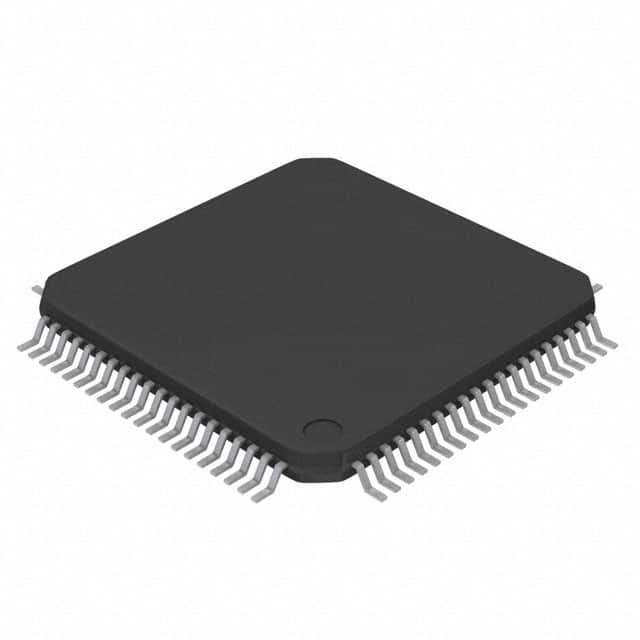Lihat spesifikasi untuk detail produk.

LC87F6D64AU-QFP-E
Product Overview
- Category: Microcontroller
- Use: Embedded systems, consumer electronics, industrial automation
- Characteristics: High-performance, low-power consumption, compact size
- Package: QFP (Quad Flat Package)
- Essence: A microcontroller designed for various applications requiring advanced processing capabilities and low power consumption.
- Packaging/Quantity: Available in tape and reel packaging, quantity varies based on customer requirements.
Specifications
- Architecture: 8-bit RISC
- Clock Speed: Up to 16 MHz
- Flash Memory: 64 KB
- RAM: 4 KB
- Operating Voltage: 2.7V - 5.5V
- I/O Pins: 32
- Communication Interfaces: UART, SPI, I2C
- Timers/Counters: 4
- Analog-to-Digital Converter: 10-bit, 8 channels
- Operating Temperature: -40°C to +85°C
Detailed Pin Configuration
The LC87F6D64AU-QFP-E microcontroller has a total of 44 pins. The pin configuration is as follows:
- VDD
- P0.0
- P0.1
- P0.2
- P0.3
- P0.4
- P0.5
- P0.6
- P0.7
- P1.0
- P1.1
- P1.2
- P1.3
- P1.4
- P1.5
- P1.6
- P1.7
- RESET
- XTAL1
- XTAL2
- P3.0
- P3.1
- P3.2
- P3.3
- P3.4
- P3.5
- P3.6
- P3.7
- GND
- AVDD
- AIN0
- AIN1
- AIN2
- AIN3
- AIN4
- AIN5
- AIN6
- AIN7
- VREF
- AGND
- P2.0
- P2.1
- P2.2
- P2.3
Functional Features
- High-performance 8-bit RISC architecture for efficient processing.
- Low-power consumption, making it suitable for battery-powered applications.
- Multiple communication interfaces (UART, SPI, I2C) for seamless integration with other devices.
- Built-in analog-to-digital converter for precise measurement and control.
- Flexible I/O pins for versatile connectivity options.
- Four timers/counters for accurate timing and event handling.
Advantages and Disadvantages
Advantages: - High-performance processing capabilities. - Low power consumption. - Compact size for space-constrained applications. - Versatile communication interfaces. - Precise analog-to-digital conversion.
Disadvantages: - Limited flash memory and RAM compared to higher-end microcontrollers. - Limited number of I/O pins for complex projects.
Working Principles
The LC87F6D64AU-QFP-E microcontroller operates based on an 8-bit RISC architecture. It executes instructions stored in its flash memory, utilizing the clock speed of up to 16 MHz. The microcontroller communicates with external devices through its various communication interfaces, enabling data exchange and control. It also features timers/counters for accurate timing and event handling. The analog-to-digital converter allows the microcontroller to measure and process analog signals. Overall, it combines processing power, low power consumption, and versatile connectivity to perform various tasks in embedded systems.
Detailed Application Field Plans
The LC87F6D64AU-QFP-E microcontroller finds applications in a wide range of fields, including:
- Embedded Systems: Used in automotive electronics, home automation, and IoT devices.
- Consumer Electronics: Found in smart appliances, remote controls, and wearable devices.
- Industrial Automation: Utilized in industrial control systems, robotics, and monitoring equipment.
- Medical Devices: Integrated into medical instruments, patient monitoring systems, and diagnostic equipment.
- Security Systems: Incorporated in access control systems, surveillance cameras, and alarm systems.
Detailed and Complete Alternative Models
- LC87F6D64AU-QFP: Similar to LC87F6D64AU-QFP-E but without extended temperature range.
- LC87F6D64AU-PLCC: Same specifications but packaged in PL
Sebutkan 10 pertanyaan dan jawaban umum terkait penerapan LC87F6D64AU-QFP-E dalam solusi teknis
Sure! Here are 10 common questions and answers related to the application of LC87F6D64AU-QFP-E in technical solutions:
Q: What is LC87F6D64AU-QFP-E? A: LC87F6D64AU-QFP-E is a microcontroller unit (MCU) manufactured by a specific company.
Q: What are the key features of LC87F6D64AU-QFP-E? A: Some key features include a high-performance CPU, various communication interfaces, multiple I/O ports, and built-in memory.
Q: What are the typical applications of LC87F6D64AU-QFP-E? A: LC87F6D64AU-QFP-E is commonly used in industrial automation, consumer electronics, automotive systems, and other embedded applications.
Q: How can I program LC87F6D64AU-QFP-E? A: You can program LC87F6D64AU-QFP-E using a compatible development environment and programming tools provided by the manufacturer.
Q: What programming languages are supported by LC87F6D64AU-QFP-E? A: LC87F6D64AU-QFP-E supports assembly language and C programming language.
Q: Can I interface external devices with LC87F6D64AU-QFP-E? A: Yes, LC87F6D64AU-QFP-E provides various communication interfaces like UART, SPI, I2C, and GPIO pins to interface with external devices.
Q: What is the maximum clock frequency supported by LC87F6D64AU-QFP-E? A: The maximum clock frequency supported by LC87F6D64AU-QFP-E is typically mentioned in the datasheet provided by the manufacturer.
Q: Can I use LC87F6D64AU-QFP-E in battery-powered applications? A: Yes, LC87F6D64AU-QFP-E is designed to operate in low-power modes, making it suitable for battery-powered applications.
Q: Are there any development boards available for LC87F6D64AU-QFP-E? A: Some manufacturers provide development boards specifically designed for LC87F6D64AU-QFP-E, which can aid in prototyping and testing.
Q: Where can I find technical documentation and support for LC87F6D64AU-QFP-E? A: You can find technical documentation, datasheets, application notes, and support on the manufacturer's website or by contacting their customer support team.
Please note that the specific details may vary depending on the manufacturer and the version of LC87F6D64AU-QFP-E you are using. It's always recommended to refer to the official documentation provided by the manufacturer for accurate information.

